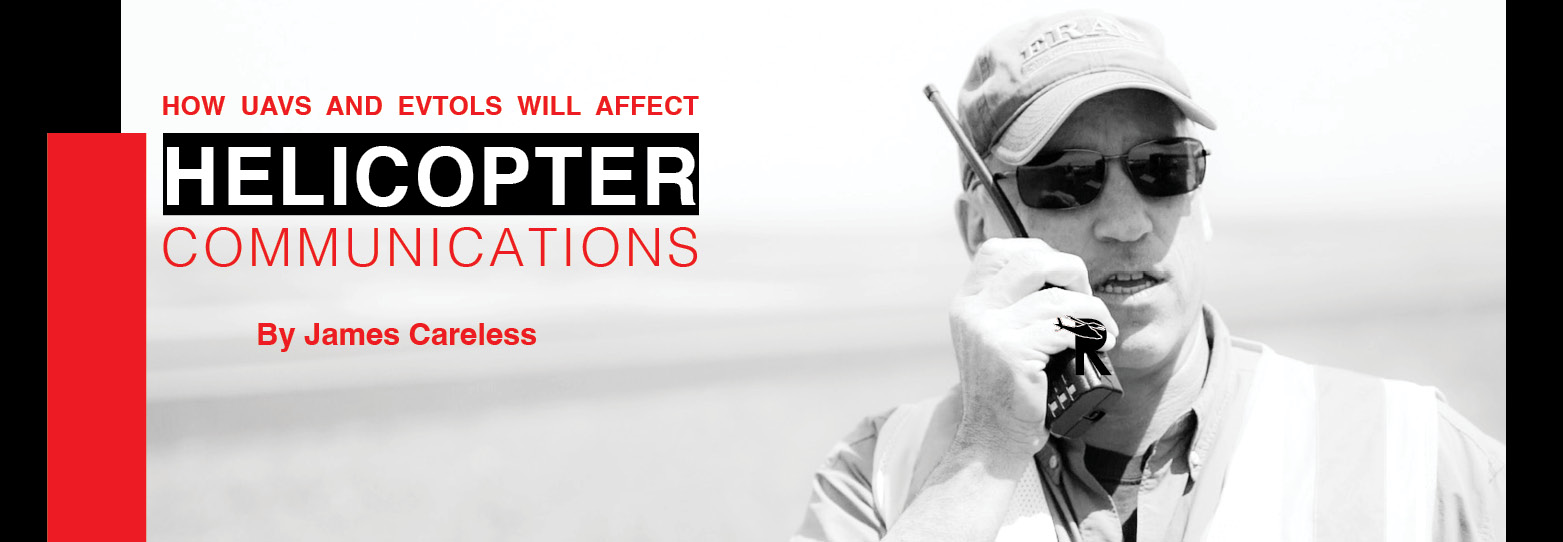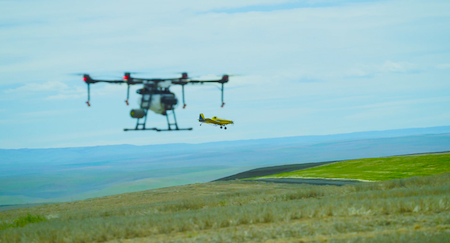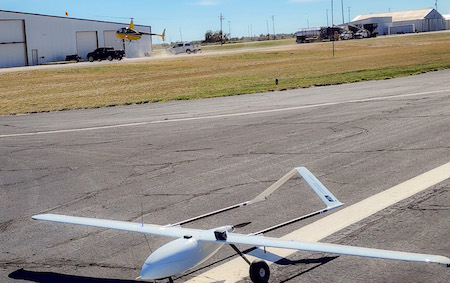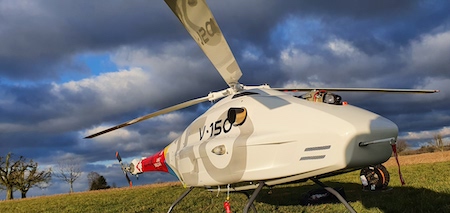|
Oct
30
2023
|
|
Posted 2 years 65 days ago ago by Admin
|
|

The growing use of UAVs (unmanned aerial vehicles) and the anticipated rollout of eVTOLs (manned electric vertical takeoff and landing vehicles) will have a far reaching impact in manned flight, as helicopters and fixed-wing aircraft must share the heavens with them. But how will UAVs and eVTOLs affect helicopter communications, especially in controlled airspace, and what will this mean for helicopter pilots and operators? Here’s what Rotor Pro has been able to find out.
Where Things Stand Now for UAVs
Given that UAVs have to conform with FAA regulations in the United States and similar regulatory authorities in other nations, their RF communications must conform to the same rules as those currently followed by helicopter and fixed-wing pilots. For instance, “all pilots, including helicopter pilots, must communicate with air traffic controllers (ATC) in airspace where communication is required,” said an FAA spokesperson.
“In only a few places are there UAVs operating in controlled airspace and communicating with ATC along with manned aircraft,” noted Dr. Scott Burgess, who is currently working on FAA-funded research at Embry-Riddle Aeronautical University’s (ERAU) Worldwide Campus. For these UAV pilots as well as those in manned aircraft, “Part 91 aircraft operations continue to operate over VHF frequencies for air traffic control management and air-to-air communications near non-towered airports.”
UMS Skeldar is a Swiss-Swedish company that designs, makes and flies two remotely controlled, payload/surveillance-capable UAVs: The V-150 SKELDAR (civilian) and the V-200 SKELDAR (naval/military).
When it comes to V-150 civilian operations in controlled and uncontrolled airspace, Joost Hamers, head of development at UMS Skeldar, said, “We have to make sure that we have flight authorization for every one of our missions. Part of that authorization includes a very clear definition of the air space we're going to operate in, along with making sure that our V-150 flights do not interfere with any regular air traffic.”

One area where UAVs are expected to shine is in beyond-visual-line-of-sight (BVLOS) missions over land in sparsely populated areas. Of course, executing such missions safely is a must for any UAV operator because airspace regulators will not allow them if they can’t be flown without putting the public at risk.
This is why UMS Skeldar has been conducting BVLOS test flights that include communications using a V-150 from its temporary base at Italy’s Taranto-Grottaglie airport. “During these two months, the crew responsible for operating the V-150 consistently liaised with regular manned traffic via Air Traffic Control (ATC),” said a UMS Skeldar news release. “When our unmanned aerial systems (UASs) fly alongside manned air traffic, the crew must book their slot time, the same way a manned aircraft would, to ensure the safety of everyone involved.”
The takeaway: Helicopter pilots need not worry that UAVs will be given some kind of ‘pass’ when it comes to following the rules of aerial communications. They won’t, which is why UAV operators like UMS Skeldar are doing their best to fit into the existing ATC system.

eVTOLs Have to Conform
Given how tightly the FAA and its sister agencies manage aircraft communications, the same rules that apply to helicopters, fixed-wing aircraft, and now UAVs will also apply to eVTOLs (aka air taxis) when they come into service.
“In FAA-controlled airspace, air taxis would follow the same rules as other aircraft,” said an FAA spokesperson. “Aircraft automation and real-time data sharing between aircraft will likely play increasing roles in these corridors keeping aircraft safely separated using industry-developed, FAA-approved rules.”
Mindful that eVTOLs are bearing down on controlled airspace, the FAA recently released “an updated blueprint to accommodate air taxis,” he added. Under the blueprint, Advanced Air Mobility (AAM) operations will begin at a low rate with air taxis flying much as helicopters do today.”
‘Urban Air Mobility (UAM) Concept of Operations’ is available online at www.faa.gov/air-taxis/uam_blueprint, this document (the FAA Blueprint) is quite clear about the FAA’s intent to regulate ‘Urban Air Mobility’ (UAM), as it calls it. “The envisioned evolution for UAM operations includes an initial, low-tempo set of operations that leverage the current regulatory framework and rules (e.g., Visual Flight Rules [VFR], Instrument Flight Rules [IFR]) as a platform,” said the FAA Blueprint’s Executive Summary. “Resulting from stakeholder input sessions, the mature state operations will be achieved at scale through a crawl-walk-run approach.”

What Needs to Change
The fact that UAV and eVTOL flights will have to conform to existing airspace regulations (including communication and coordination with air traffic control) does not mean that the current state of aerial communications will remain unchanged — because it won’t. In fact, the experts consulted for this story have plenty of changes in mind.
A case in point: Paragraph 151 of the FAA’s proposed “Spectrum Rules and Policies for the Operation of Unmanned Aircraft Systems” released on 7 February 2023 for public comment, says “to further promote the safe integration of unmanned aircraft operations in controlled airspace and facilitate flight coordination, the NPRM (Notice of Proposed Rulemaking), proposes a process for UAS operators to obtain a VHF license to communicate with air traffic control and other aircraft.”
Such a move to improve communications between UAV pilots and manned aircraft makes sense to Burgess. “Since Part 107 confines UAVs to operate below 400’ AGL, it would seem logical to have radio communications between an RPIC (Remote Pilot in Command) and an airborne pilot,” he said.
Burgess’ recommendation is based on actual experience. “ERAU training students have flown UAVs at a private strip with owner permission,” he said. “Sometimes a manned airplane or helicopter will fly below 400 feet directly over this strip, and some have even attempted to land.. This is why we broadcast on the local flight following frequency in the interest of flight safety — and we are Part 61 rated.”
“Of course, “teaming” (combining manned and unmanned aircraft together as a coordinated aerial unit) would encompass more communications capacity,” observed Burgess. “This may need to be addressed as to discrete frequencies for ground-to-air communication between teaming members.”
Amol Parikh, vice president of marketing at Doodle Labs, a provider of high-bandwidth, multi-frequency mesh datalinks for extended range UAV operations, emphasized the critical role of regulatory measures and innovative technology in the future of shared airspace. He pointed out, 'With the adoption of measures like RemoteID and the FCC's spectrum management initiative, along with the integration of advanced communications technology in UAVs, we can more effectively avoid frequency conflicts with other aircraft,” he said. “This not only increases safety but also paves the way for a future where manned and unmanned aircraft coexist harmoniously in the same airspace.'"
UMS Skeldar’s Hamers believes that ATC needs a significant overhaul not just to handle the influx of UAVs and eVTOLs into controlled airspace, but also to keep up with the increasing number of manned helicopters and fixed-wing aircraft. “What is needed is digitalization of the airspace’,” he said. “This means moving to digital broadband data and voice communications with all aircraft while gradually superseding VHF radio, “which is a World War II-era technology that we still use and cling to. In today's world, sticking with VHF starts to become ridiculous and not sustainable, especially if you add unmanned traffic to the mix.”

When it comes to decluttering aviation VHF frequencies, Burgess pointed to the military’s use of FM radios for short-range communications. (AM radio has the benefit of being able to travel beyond the horizon by bouncing radio waves off the ionosphere and back to the ground. FM does not.) After all, “communications between air and ground have been utilized for decades in the military over FM frequencies with great success,” he noted.
Back to digitalization of the airspace. As air taxis catch on with the urban public and the number of these eVTOLs in service becomes significant, “aircraft automation and real-time data sharing between aircraft will likely play increasing roles in these corridors,” said the FAA spokesperson. “With an eye toward the greater automation we know must come, the FAA has been conducting demonstrations with NASA and industry stakeholders and others at test sites since 2019. The test results provide us with information to develop policies and standards to support routine operations. Among other things, we have tested increasingly large and complex operations and information-exchange between airspace-management service providers and between service providers and the FAA, including message security.”
The results of these tests have convinced the FAA that aerial communications need to evolve to incorporate large two-way data transfers. To address this drive for digitalization of the airspace, “we’ll develop open standards for commercial data exchange through the cloud,” he told Rotor Pro. “We’re making good, steady progress on interface standards. We understand what the companies’ objectives are and know what we need to do to meet their needs. It’s all going to be at scale. The questions are: At what level? When do they get to scale?”
It’s worth noting that the FAA claims it has proven it can move fast to automate a function, citing the Low Altitude Authorization and Notification Capability (LAANC) for drones as an example.
What This All Means for Helicopter Pilots
In the case of helicopter communications, the key point that pilots need to be aware of is not how UAVs and eVTOLs in themselves will change the nature of aerial communications, but rather how these communications are likely to change in themselves.
The success of broadband wireless on consumer smartphones/tablets, and the advent of satellite broadband services to aircraft (along with ground-based aerial broadband provided by SmartSky Networks), are making it possible for helicopters and fixed-wing aircraft to move to communications platforms that outstrip VHF radio.
This is not to say that VHF will disappear, only that it will be increasingly supplemented by these and other broadband data avenues in the air. This, in turn, will allow the FAA and other regulatory agencies to implement much more sophisticated and capable communications systems for aircraft — eventually allowing the influx of UAVs and eVTOLs into controlled airspace to be taken in stride. When this happens, helicopter pilots will likely find that their aerial communications environment improved, not degraded, as UAVs and eVTOLs become common airspace partners. In this regard, the future is worth looking forward to, rather than fearing.
READ MORE ROTOR PRO: https://justhelicopters.com/Magazine
WATCH ROTOR PRO YOUTUBE CHANNEL: https://buff.ly/3Md0T3y
You can also find us on
Instagram - https://www.instagram.com/rotorpro1
Facebook - https://www.facebook.com/rotorpro1
Twitter - https://twitter.com/justhelicopters
LinkedIn - https://www.linkedin.com/company/rotorpro1